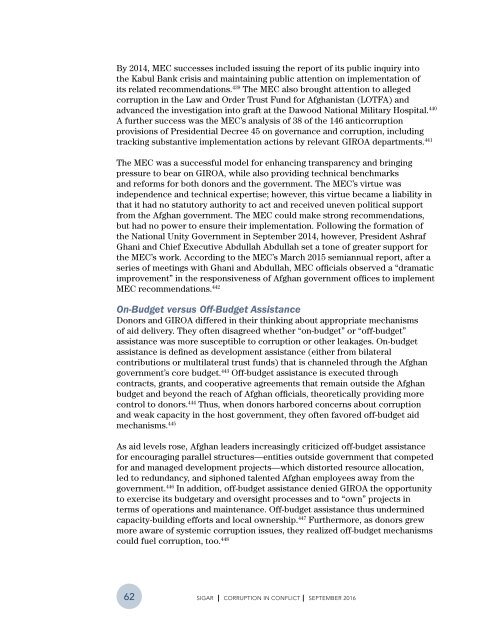CORRUPTION IN CONFLICT
5IlaWjQej
5IlaWjQej
Create successful ePaper yourself
Turn your PDF publications into a flip-book with our unique Google optimized e-Paper software.
By 2014, MEC successes included issuing the report of its public inquiry into<br />
the Kabul Bank crisis and maintaining public attention on implementation of<br />
its related recommendations. 439 The MEC also brought attention to alleged<br />
corruption in the Law and Order Trust Fund for Afghanistan (LOTFA) and<br />
advanced the investigation into graft at the Dawood National Military Hospital. 440<br />
A further success was the MEC’s analysis of 38 of the 146 anticorruption<br />
provisions of Presidential Decree 45 on governance and corruption, including<br />
tracking substantive implementation actions by relevant GIROA departments. 441<br />
The MEC was a successful model for enhancing transparency and bringing<br />
pressure to bear on GIROA, while also providing technical benchmarks<br />
and reforms for both donors and the government. The MEC’s virtue was<br />
independence and technical expertise; however, this virtue became a liability in<br />
that it had no statutory authority to act and received uneven political support<br />
from the Afghan government. The MEC could make strong recommendations,<br />
but had no power to ensure their implementation. Following the formation of<br />
the National Unity Government in September 2014, however, President Ashraf<br />
Ghani and Chief Executive Abdullah Abdullah set a tone of greater support for<br />
the MEC’s work. According to the MEC’s March 2015 semiannual report, after a<br />
series of meetings with Ghani and Abdullah, MEC officials observed a “dramatic<br />
improvement” in the responsiveness of Afghan government offices to implement<br />
MEC recommendations. 442<br />
On-Budget versus Off-Budget Assistance<br />
Donors and GIROA differed in their thinking about appropriate mechanisms<br />
of aid delivery. They often disagreed whether “on-budget” or “off-budget”<br />
assistance was more susceptible to corruption or other leakages. On-budget<br />
assistance is defined as development assistance (either from bilateral<br />
contributions or multilateral trust funds) that is channeled through the Afghan<br />
government’s core budget. 443 Off-budget assistance is executed through<br />
contracts, grants, and cooperative agreements that remain outside the Afghan<br />
budget and beyond the reach of Afghan officials, theoretically providing more<br />
control to donors. 444 Thus, when donors harbored concerns about corruption<br />
and weak capacity in the host government, they often favored off-budget aid<br />
mechanisms. 445<br />
As aid levels rose, Afghan leaders increasingly criticized off-budget assistance<br />
for encouraging parallel structures—entities outside government that competed<br />
for and managed development projects—which distorted resource allocation,<br />
led to redundancy, and siphoned talented Afghan employees away from the<br />
government. 446 In addition, off-budget assistance denied GIROA the opportunity<br />
to exercise its budgetary and oversight processes and to “own” projects in<br />
terms of operations and maintenance. Off-budget assistance thus undermined<br />
capacity-building efforts and local ownership. 447 Furthermore, as donors grew<br />
more aware of systemic corruption issues, they realized off-budget mechanisms<br />
could fuel corruption, too. 448<br />
62<br />
SIGAR I <strong>CORRUPTION</strong> <strong>IN</strong> <strong>CONFLICT</strong> I SEPTEMBER 2016


